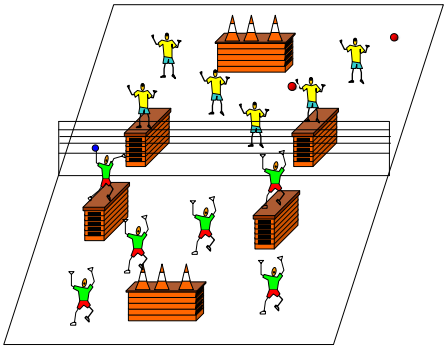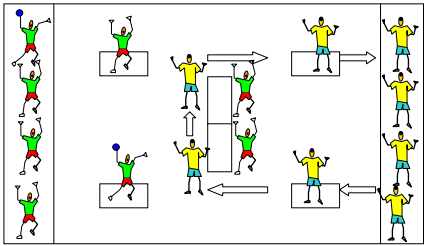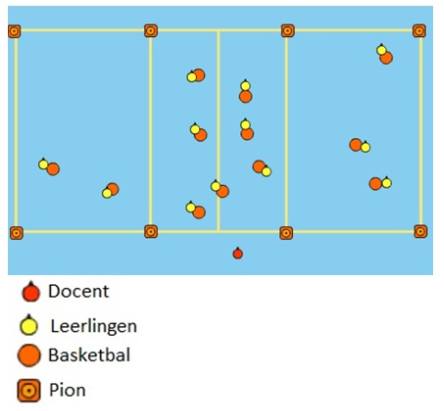Volleyball drills for technique general
- The 2 throwers stand on the boxes and the attackers walk on the ground.
- The throwers and attackers try to knock over the pylons or throw off attackers at the opposing team.
Rules:
- You are not allowed to defend your pylons, you can use chalk to make a circle in which the pupils are not allowed to stand.
- As a thrower and as a declarer you can choose to aim at the declarer or at the pylons.
- The defender is not allowed to fend off but if he catches the ball the thrower is out and a new thrower has to come in
- When a player is thrown out, he/she has to sit on the waiting bench, when a pylon of the opposing team is knocked down, all the keepers can go in again.
- Throwers cannot be thrown off.
- When the opponent's pylons have been knocked down, you have won the game, or when all of the opponents' helpers have been removed.

- Divide the group into two teams.
- From both teams 2 children stand on the mats belonging to their team.
- Also 2 children per team stand in front of the cupboard, these are the goalkeepers.
- The children who stay over, go to the throwing square (see drawing).
- When the balls come into play, the children in the box are supposed to throw the balls against the cupboard.

Four exercises are set out, which are completed in time. The teams collect points. After the 4 exercises a mini tournament is played, where all teams play against each other.
- Exercise 1. This is done together. All teams do the same exercise at the same time. Two players lie side by side on their stomachs behind the back line. Number one of the team jumps up and runs to the net. When nr.1 is lying on his belly, nr.2 can leave.
- Exercise 2. No. 1 hits with smash the ball via the ground and the wall to no. 2. No. 1 stands behind a line with two pawns, no. 2 stands on the mat.
- Exercise 3. Nr. 1 serves from behind the 7 meter line, to nr. 2. Nr. 2 passes the ball to himself and plays immediately with an overhand ball the ball over the net to nr. 1. Every good ball that is caught is 1 point. After 2 minutes you can change.
- Exercise 4. No. 1 runs with the ball to the net, from a pylon, passes the ball under the net to No. 2. No. 2 runs with the ball in her hands to her own pilar and back again. Nr.2 then throws the ball over the net to nr.1. Nr.1 runs to her own pilon, and returns to pass the ball under the net. Etc.
Tournament:
- team 1 - team 2 5 minutes
- team 3 - team 4 5 minutes
- team 1 - team 3 5 minutes
- team 2 - team 4 5 minutes
- team 1 - team 4 5 minutes
- team 2 - team 3 5 minutes
followed by possibly a big game.
What you need:
- Exercise 2. mat and 2 pawns, some balls
- Exercise 3. some balls and antenna makes smaller field.
- Exercise 4. single balls and aerial
- The teacher sets out three areas of approximately equal size with pawns.
- It is best to use the volleyball lines (see map).
- There are three sections (see map):
- Left: barons square (losers square)
- Centre: princes section (neutral section)
- Right: king of the court (winner section)
- All students stand in the middle section.
- With a signal from the teacher the game starts.
- All pupils have to try to tap/strike the ball of another pupil out of the box.
- If you succeed you move one square to the right.
- If your ball is knocked away you move up one square to the left.
- If you hit/tap someone's ball out of the box on the right you score a point.
- If your ball is knocked out of the winner's box you lose all your points.
- If your ball is knocked out of the left box nothing happens and you stay standing.
- When the teacher gives the final signal the person with the most points is king of the court and he/she has won.

Match 2 v 2, where the 3m line is the back line (and less wide)
- variations:
- obligatory all abovehands; also 1st ball!
- obligatory all underhand
- obligatory 3rd ball with 1 hand
- etc
- throw the ball with 2 hands
- catch with 1 hand
- change hands 3 times
- throw the ball with 1 hand
- catch with 2 hands
- 3x
- throw the ball with 1 hand
- catch with 1 hand
- 3x right + left
- 2 groups, each group on one side of the net.
- Overhead over the net.
- When you've played you join the back of the row.
- later underhand
Equipment: cones + tennis balls
- 2 pairs; per pair 1 tennis ball and 1 pawn
- A throws the tennis ball with a bow to B
- B catches the ball using the overhand technique with the cone
- If this goes well -> alternate short ball/long ball
- and/or sideways movement, i.e. throw to the left or right of the person
After each part, a short rest and then through again. Parts with * need a bench, 2 to 4 persons per bench
- Part 1:
- 30 step-ups* (getting on/off the bench)
- 15 push-ups* (feet on the bench)
- 30 step-ups*(get on/off bench)
- 15 push-ups* (feet on the bench)
After each part, a short rest and then through again. Parts with * need a bench, 2 to 4 persons per bench
- Part 1:
- 30 step-ups* (getting on/off the bench)
- 15 push-ups* (feet on the bench)
- 30 step-ups*
- Part 2:
- 30 east-west step-ups* (right foot on bench left foot next to it â€" left foot on it right foot next to it)
- 10 squats jumps (bend knees and jump as high as possible while stretching)







